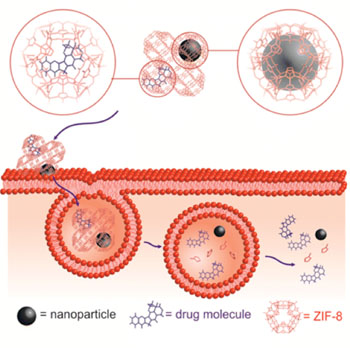Smart Drug-Delivery Cage Designed to Fight Cancer
By LabMedica International staff writers
Posted on 05 Jun 2014
Chemists have developed a nano-scale cage of chemical bonds that entraps small molecule drugs and then infiltrates cancer cells, showing potential to act as a “smart” drug-delivery processes to fight cancer and other disorders.Posted on 05 Jun 2014
Boston College (Chestnut Hill, MA, USA) Assistant Professors of Chemistry Drs. Frank Tsung and Eranthie Weerapana developed the chemical framework, a “nanosphere” cultivated with a combination of metal and organic substances. Laboratory tests showed the nanospheres effectively penetrated and killed breast cancer cells. “We were very excited to see the results,” said Dr. Tsung. “We always want our solutions to work, but to see our organic-based drug delivery system attack and kill cancer cells in our lab tests was extremely gratifying. We know there is much work to be done, but we’re excited about the potential in this advance.”

Image: A general synthetic route was developed to encapsulate small molecules in monodisperse zeolitic imid-azolate framework-8 (ZIF-8) nanospheres for drug delivery. Electron microscopy, powder X-ray diffraction, and elemental analysis show that the small-molecule-encapsulated ZIF-8 nanospheres are uniform 70-nm particles with single-crystalline structure. Several small molecules, including fluorescein and the anticancer drug camptothecin, were encapsulated inside of the ZIF-8 framework. Evaluation of fluorescein-encapsulated ZIF-8 nanospheres in the MCF-7 breast cancer cell line demonstrated cell internalization and minimal cytotoxicity. The 70 nm particle size facilitates cellular uptake, and the pH-responsive dissociation of the ZIF-8 framework likely results in endosomal release of the small-molecule cargo, thereby rendering the ZIF-8 scaffold an ideal drug delivery vehicle. To confirm this, the researchers demonstrated that camptothecin encapsulated ZIF-8 particles show enhanced cell death, indicative of internalization and intracellular release of the drug. To demonstrate the versatility of this ZIF-8 system, iron oxide nanoparticles were also encapsulated into the ZIF-8 nanospheres, thereby endowing magnetic features to these nanospheres Photo courtesy of the American Chemical Society (ACS) journal ACS Nano).
In the search to enhance the work of drugs that fight cancer and other diseases, researchers have looked for ways to exploit the benefits of nanotechnology, in this case a nanoscale metal organic framework (MOF). These frameworks have proven useful in certain functions, but until now demonstrated instability in the body’s watery environment, according to Dr. Tsung.
Therefore, Drs. Tsung and Weerapana set out to create a framework that can effectively transport the drug through the body and deliver it to target cells. Efficiency is a crucial issue, as some drugs fail to fully penetrate cell membranes. Some drugs erode before they find their targets, requiring increased dosages, which are expensive and can produce annoying side effects in patients.
Drs. Tsung and Weerapana’s nanosphere overcomes these significant challenges, the two faculty members reported on March 25, 2014, in the American Chemical Society (ACS) journal ACS Nano. Dr. Tsung and researchers in his lab were able to cultivate the nanospheres by creating organic links between tens of thousands of zinc ions, essentially creating a constellation of 800 tiny cage-like structures capable of entrapping small molecules. The overall size of these constellations must be large enough to transport proper dosage, yet small enough to penetrate the target cell membrane. “That size between 50 and 100 nm is the magic number,” said Dr. Tsung. “If you have too small a framework, it won’t work. If we stay between 50–100 nm, it can penetrate the cancer cell. Our nanosphere is in the 70-nm range, which we think is ideal.”
Next, the researchers had to retain some control on the structure, so that it would release the drug dosage once it entered the cancer cell membrane. The investigators then utilized a unique property of the framework that would trigger drug release based on a decrease in pH levels. Whereas the body’s pH level is 7.4, the extracellular microenvironments of cancer cells typically have lower pH. Upon entering the cancer cell, the lower pH level triggers a chemical reaction that releases the drug, according to Dr. Tsung.
“It is the body’s own mechanisms that trigger the release of the drug, which is a huge advantage,” Dr. Tsung said. “When the nanosphere enters the cancer cell, the lower pH level destabilizes the structure, which begins to break apart and releases the drug so it can begin to do its job of attacking and killing cancer cells.”
Dr. Tsung reported that their research showed that targeting could be improved by incorporating iron oxide into the structure and using an external magnetic field to direct the drug to the target cells. He noted that the researcher’s next step is to functionalize the compound with antibodies to use the body’s own immune response to attract the nanosphere to the disease cells. Dr. Tsung stated that the organic components in the nanosphere might make it easier to functionalize with an antibody.
According to Dr. Tsung, nanospheres are non-toxic, and they achieved the unique structure by carefully controlling temperature during fabrication. Furthermore, the structures were cultivated from low-cost, readily available materials that can help cut costs.
Related Links:
Boston College















